In cooking, as in all the arts, simplicity is the sign of perfection. - Curnonsky
The Far Breton aux Pruneaux is a deep-rooted culinary tradition in the Brittany region of France, a dessert specialty which can be traced back at least to the 18th Century. But its roots go much deeper. Far comes from the Breton farz forn: farz referring to flour or grain, spelt, wheat, or even a type of gruel or oatmeal; forn meaning oven. So flour or the grain it comes from in the oven, which is basically the origin of the dish. Today farz refers to the dish fairly close to what it originally was, a savory pudding or porridge of buckwheat bound with a little eggs and milk, tied tightly into a cloth sack and cooked in the broth of a pot-au-feu - in Brittany that’s Kig-ha-farz = as the meat and vegetables cook. To serve, it is pushed out of the sack and broken up and rubbed into crumbs. Buckwheat, being a fundamental ingredient in Breton cuisine (think buckwheat galette, their traditional savory crêpes), the farz was a staple dish, cheap, filling, and nutritious, and gradually evolved into the base for both savory and sweet dishes, sugar and dried fruits being added to create a dessert.
Families that could afford more costly ingredients such as eggs and butter, for example, added them to create the sweet version of the farz, and over time, as the dish evolved, the quantity of flour was reduced and replaced with more of the richer ingredients.
Far is a dessert, an oven-baked, barely sweet, custard-like flan. The batter is similar to both clafoutis and crêpe batters, the baked far denser than a clafoutis, lighter and creamier than a flan. It is usually and traditionally studded with prunes (often soaked in rum before adding to the batter), as prunes were a staple of the fishing and seafaring Bretons, a nutritious food easy to conserve and carry on long voyages.
The cuisine of Brittany is rustic, familial, hearty and simple. And, of course, much of it coming from the sea. The seafood platter or huge bowlfuls of steaming mussels cooked in wine are gastronomic standards. La Cotriade, a type of fish and seafood stew, is the perfect way to warm up a blustery winter day. Kig-ha-farz, mentioned above, is the local variation of pot-au-feu based on lard, pork and hearty, earthy vegetables like potatoes, onions, rutabagas, carrots and cabbage. Brittany pork is an appreciated local specialty, often eaten in the form of Andouille de Guémené, a type of sausage. And the classic galette, a savory crêpe made of local buckwheat flour, filled with almost anything you please but more often than not, something with a seafood or pork twist to it. And all of it washed down with cider or lait ribot, buttermilk, the favored drinks of this region.
As for their desserts, most of us are familiar with the classic crêpe, often filled simply with salted butter and sugar, apples, or caramel au beurre salé, another speciality of the region. And of course Kouign Amann, a cake made of butter and sugar-infused bread dough covered with a fine layer of puff pastry. Or the lesser known Farz Buan, a quick dessert somewhere between a flan and a crêpe, or the palet, Brittany’s own butter cookie. But most people outside of France are more familiar with the clafoutis than the far, or, for that matter, their cousin flognarde or flaugnarde, the variation found in the region of Limousin and Périgord.
Nothing is easier to make, nor can you find a tastier, homier, more traditional dessert than the far Breton!
One of my most memorable meals was at Prat Ar Coum in Lannilis on the north coast of Brittany, halfway between 2 abers, narrow bays, the Aber-Benoît and the Aber-Wrac'h, both opening into the Channel. The Madec family have been ostréiculteurs, oyster farmers, on this spot since 1898. We had eaten their famous Prat-ar-coum oysters in our own tiny corner of Brittany, Nantes, when we lived there, and when invited by friends to spend a short vacation in Brest several years ago, knew we had to track these treasures at their source, eat them straight out of the water. We found the Prat-Ar-Coum vivier – the warehouse filled wall to wall with rows of open tanks separated by cement-floored alleys, men and women decked out in rubber boots, rubber aprons, and rubber gloves stomping through puddles from tank to huge tank, scooping out live beasts, crabs, lobsters, clams, scallops, and, of course, oysters galore and bagging them for clients, or shoving them in the floor-to-ceiling cookers so one could then head home with freshly-steamed seafood, yes we found the warehouse where chefs and fishmongers, locals and tourists alike stand elbow to elbow waiting patiently their turn, ogling the living treasures as in some museum, pointing out the one wanted. And nestled behind the vivier, hidden away from all but the most devoted, we were surprised to discover, was a tiny restaurant.
That night we returned and dined on oysters and fresh lobster, the only things on the menu were what was contained in tanks next door, simply steamed, washed down with glasses of crisp white wine. And as we were finishing, sated and content, we spied a woman through the fading light of late evening slowly heading towards the restaurant from a house off in the distance, its light-infused windows bright and cheery. And she was carrying a large baking tray evidently hot from the oven, if the tea towels with which she was gripping the pan were any clue. And as she got closer and stepped through the door of the dining room, we saw that she was carrying dessert baked in her own home at the end of the lane. A far Breton, the only dessert on the menu. And thick, creamy slabs, warm and tender, of that far, dusted simply with powdered sugar, were served to each diner.
Originally given to me by my friend Isabelle who I was visiting on that trip to Brest, I adjusted this recipe until it came out just the way I love far. And I make it 2 ways.
Far Breton with Prunes
The Far Breton is best eaten warm, dusted with powdered sugar. Once it cools to room temperature or is chilled in the refrigerator, it firms up further and has a slightly denser consistency like that of a good flan, yet still remains creamier than a classic flan. I love it at any temperature.
1 slightly heaping cup (approximately 175 grams) pitted prunes
2 tablespoons rum (*see note)
3 large eggs
½ teaspoon vanilla
4 tablespoons (60 grams) sugar
4 gently rounded (not heaping) tablespoons (75 grams or a bit more) flour (**see note)
Pinch salt (add 2 pinches salt if using unsalted butter for the dish)
2 cups (450 ml, just under ½ litre) whole milk, room temperature or warm (***see note)
1 tablespoon (15 grams) salted butter for the baking dish
* If you prefer not to add rum, simply soak the prunes in only hot water until plumped and softened, but feel free to increase the amount of rum in the recipe as well
** Preparing the batter ahead of time and letting it rest for 2 hours before baking allows each “grain” of flour to absorb liquid from the milk-and-egg batter; the starch swells creating a network of gluten that thickens the batter (this is more visible with crêpe batter which contains more flour) creating a more tender far.
*** It is strongly recommended to use whole milk for this recipe as the fats produce a creamier, more tender far and keep it that way longer without drying out. Some people recommend warming the milk before adding it to the batter, allowing the warm milk to begin to delicately “cook” the batter helping to prevent the separation of the batter during baking.
Prepare the batter and the prunes about 2 hours ahead of baking.
Place the prunes in a small bowl and add the 2 tablespoons rum; I add 2 or 3 tablespoons hot tap water along with the rum so the prunes are all at least partially immersed in liquid. Toss and set aside. Toss the prunes in the liquid occasionally so all are evenly macerated.
Break the 3 eggs into a mixing bowl and whisk until very well blended. Whisk in the vanilla and the sugar.
Gradually and carefully whisk in the flour and salt combined, whisking in a few tablespoons at a time and blending after each addition until you obtain a smooth, lump-free paste.
Once all of the flour/salt is blended in and the batter is very smooth and creamy, stir in about a third of the milk to loosen the batter. Stir or whisk in the milk in an additional 2 or 3 additions, being careful not to splatter!
Cover the bowl of batter with a plate and set aside at room temperature to rest for at least 2 hours.
Preheat the oven to 425°F (220°C).
Drain the prunes, discarding the liquid. Set the strainer with the prunes back over the bowl to continue to drip-drain while preparing the baking dish.
Put the butter in a glass/Pyrex or terra cotta baking dish measuring approximately 12 x 8 x 1 ½ - inches (30 x 21 x 3 cm) rectangular or 8-inch (21-cm) square baking dish – and place in the hot oven until the butter melts. Carefully remove the baking dish from the oven and swirl and brush to evenly coat both the bottom and the sides of the dish.
Spread the plumped prunes (do not add any of the macerating liquid) evenly over the bottom of the baking dish. Whisk the batter to blend then pour the batter over the prunes.
Place the baking dish in the oven and immediately lower the oven temperature to 375°F (190°C).
Bake the far until just firm, puffed and golden around the edges and bottom, about 30 minutes. Although the far will come out of the oven puffed, it will sink as it cools and this is perfectly normal.
The Far Breton is best eaten slightly warm, dusted with powdered sugar. Once it cools to room temperature or is chilled in the refrigerator, it firms up further and has a slightly denser consistency like that of a good flan, yet still remains creamier than a classic flan.
Far Breton aux Griottes
This is an ideal recipe for winter or when cherries are not in season (or are too pricey) when you still crave this sweetest of fruits. I always have a jar or two of sour cherries – griottes – in my pantry for when the cherry craving hits.
You simply need 1 cup drained jarred pitted cherries
Drain the jarred cherries, reserving the liquid/juice for another use. Measure out a slightly heaping cup of the cherries.
Spread them in the hot, buttered baking dish in place of the rum-soaked prunes and carry on…
Thank you for subscribing to my Substack, Jamie Schler’s Newsletter, where I share my (mostly French) recipes, my hotel and my jams, my projects, and the stories of my life. You can support my work by sharing the link to my Substack with your friends, family, and your social media followers. I’m so glad that you’re here.




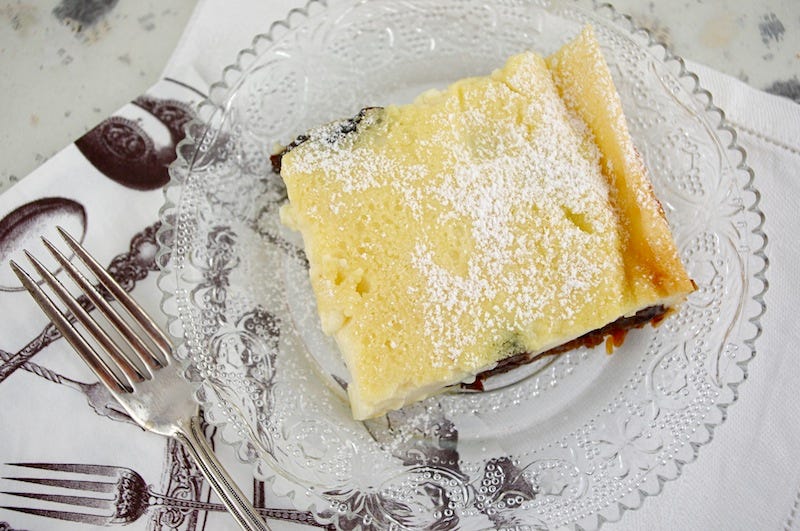
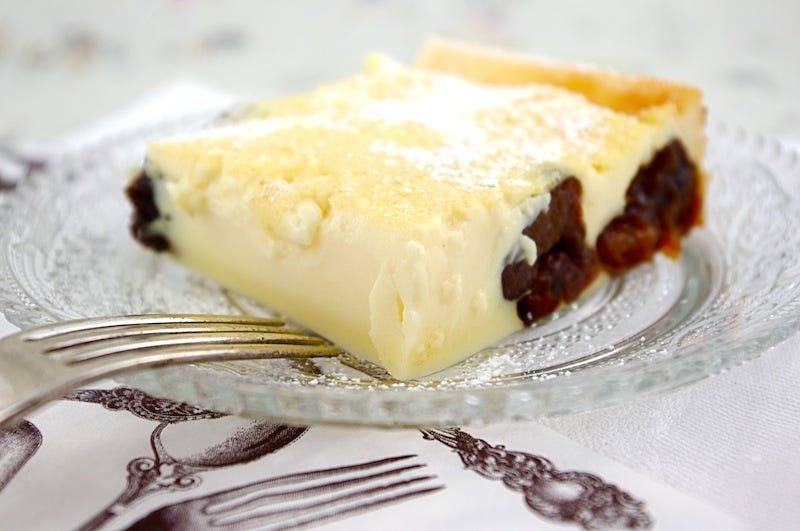
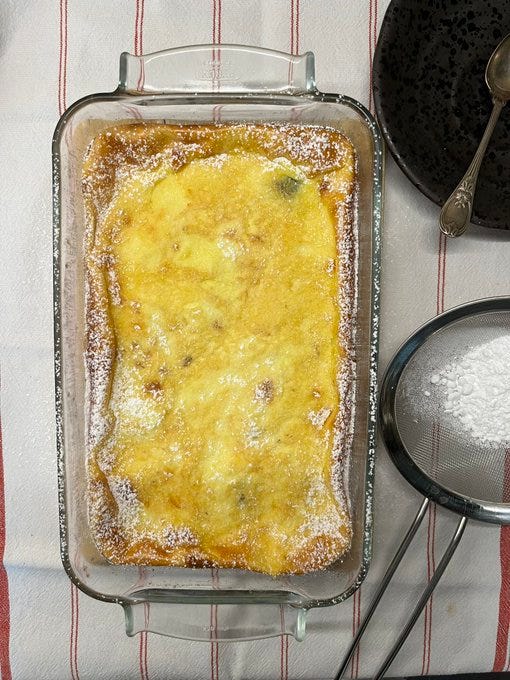
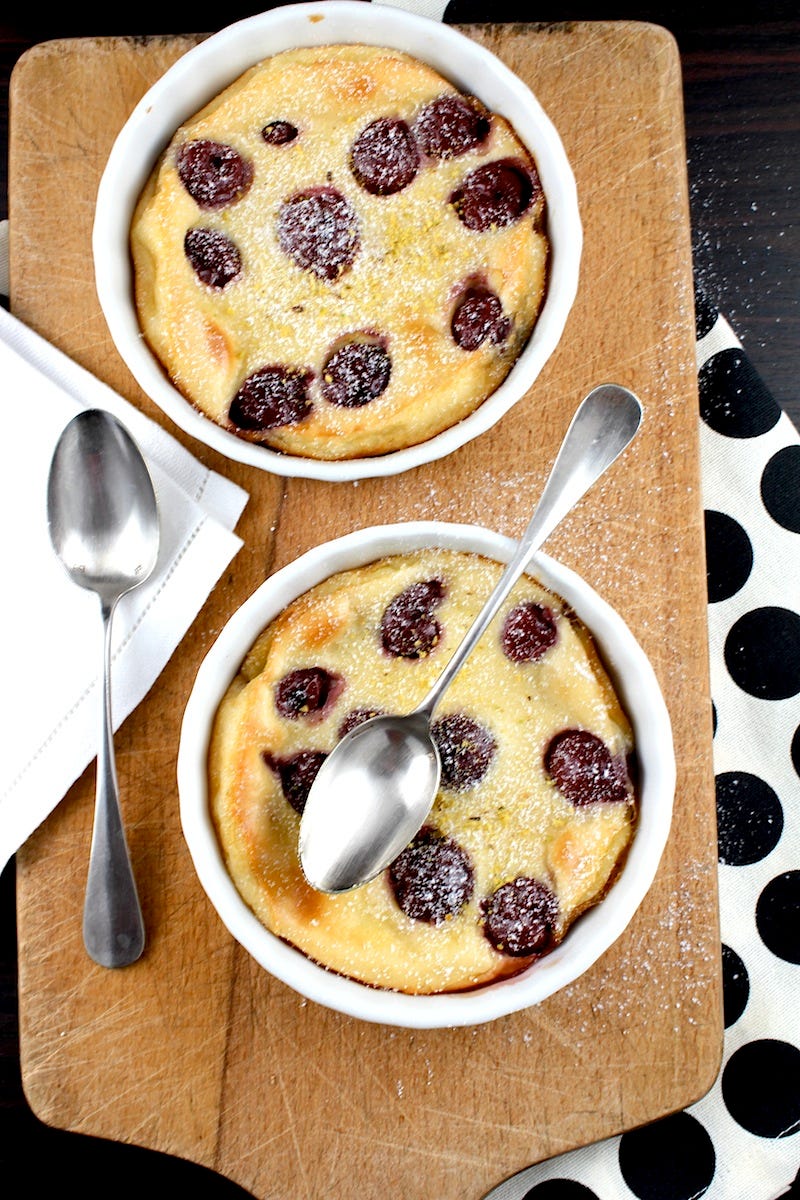
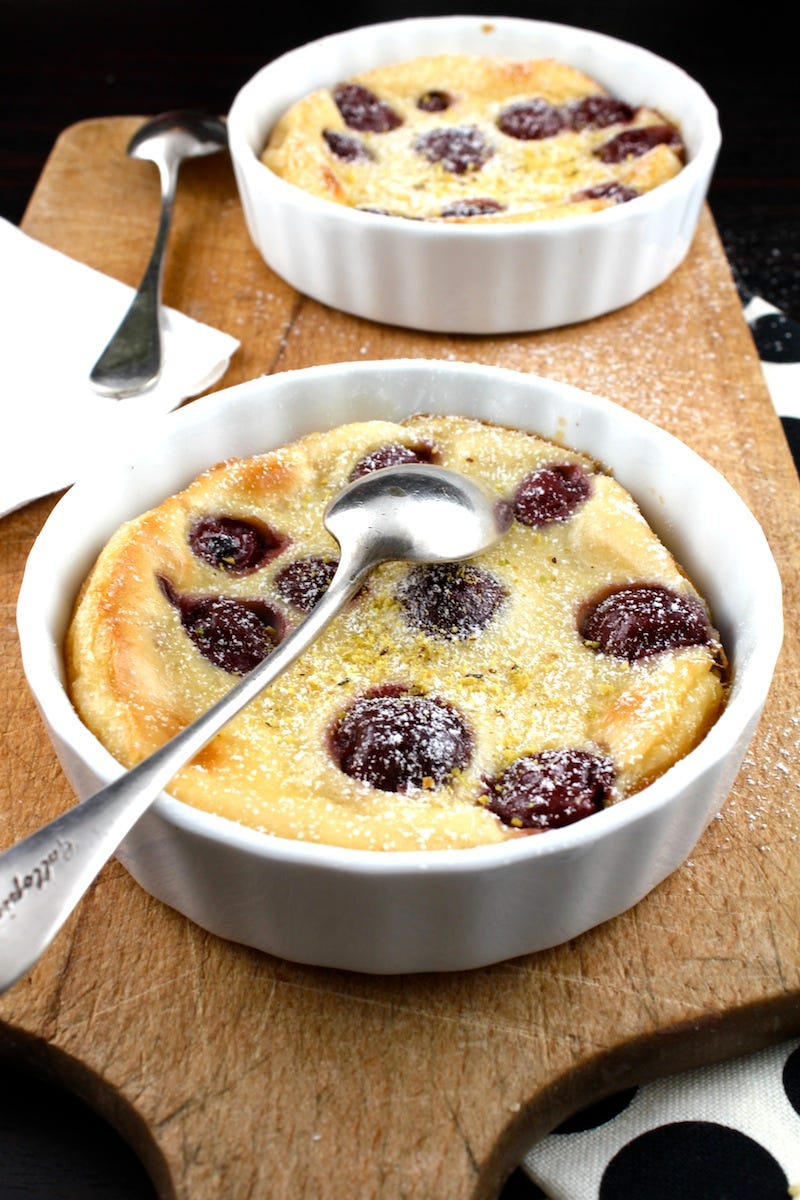
Trust me, I am a HUGE fans her writing. I own and have read all of her books, some several times, especially when I need comforting. Jacques and I even visited Dijon using her book as our guide and then drove down to Aix-en-Provence to eat at Chez Thomé at Le Tholonet https://www.chezthome.fr.
Lovely writing, parts remind me of MFK Fisher’s writing on food and places, had she gone to Brittany.